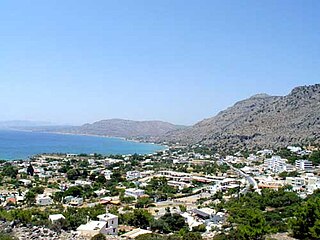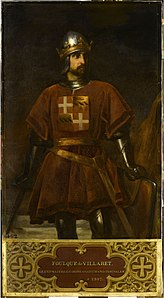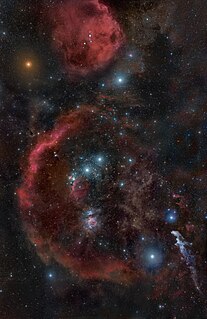
The Dorians were one of the four major ethnic groups among which the Hellenes of Classical Greece considered themselves divided. They are almost always referred to as just "the Dorians", as they are called in the earliest literary mention of them in the Odyssey, where they already can be found inhabiting the island of Crete.

The Colossus of Rhodes was a statue of the Greek sun-god Helios, erected in the city of Rhodes, on the Greek island of the same name, by Chares of Lindos in 280 BC. One of the Seven Wonders of the Ancient World, it was constructed to celebrate Rhodes' victory over the ruler of Cyprus, Antigonus I Monophthalmus, whose son Demetrius I of Macedon unsuccessfully besieged Rhodes in 305 BC. According to most contemporary descriptions, the Colossus stood approximately 70 cubits, or 33 metres high—the approximate height of the modern Statue of Liberty from feet to crown—making it the tallest statue of the ancient world. It collapsed during the earthquake of 226 BC; although parts of it were preserved, it was never rebuilt.
In Greek mythology, the Telchines were the original inhabitants of the island of Rhodes, and were known in Crete and Cyprus.

Agesander was one, or more likely, several Greek sculptors from the island of Rhodes, working in the first centuries BC and AD, in a late Hellenistic "baroque" style. If there was more than one sculptor called Agesander they were very likely related to each other. The very important works of the groups of Laocoön and his Sons, in the Vatican Museums, and the sculptures discovered at Sperlonga are both signed by three sculptors including an Agesander.

Rhodes is the principal city and a former municipality on the island of Rhodes in the Dodecanese, Greece. Since the 2011 local government reform it is part of the municipality Rhodes, of which it is the seat and a municipal unit. It has a population of approximately 90,000 in its metropolitan area. Rhodes has been famous since antiquity as the site of Colossus of Rhodes, one of the Seven Wonders of the Ancient World. The citadel of Rhodes, built by the Hospitalliers, is one of the best-preserved medieval towns in Europe, which in 1988 was designated as a UNESCO World Heritage Site.

Bryges or Briges is the historical name given to a people of the ancient Balkans. They are generally considered to have been related to the Phrygians, who during classical antiquity lived in western Anatolia. Both names, Bryges and Phrygians, are assumed to be variants of the same root. Based on archaeological evidence, some scholars such as Nicholas Hammond and Eugene N. Borza argue that the Bryges/Phrygians were members of the Lusatian culture that migrated into the southern Balkans during the Late Bronze Age.

The Bronze God of Rhodes is an historical novel by American writer L. Sprague de Camp. It was first published in hardcover by Doubleday in 1960, and in paperback by Bantam Books in 1963. A trade paperback edition was projected by The Donning Company for 1983, but never published. The book was reissued with a new introduction by Harry Turtledove as a trade paperback and ebook by Phoenix Pick in June 2013. It is the second of de Camp's historical novels in order of writing, and fourth in internal chronology.

Pefkos or Pefki, Greek: Πεύκος (Πεύκοι), is a well known beach resort located on eastern coast of Rhodes, just a few kilometers south of Lindos, 56 kilometres (35 mi) from the capital city Rhodes. The island of Rhodes is the largest of the Dodecanese islands, on the eastern Aegean Sea, just a few miles from the coast of the Asia Minor. Pefkos was once known as a fishermen's hamlet located along the coastal road that connects the villages of Lindos and Lardos. Originally Pefkos was mainly used as a summer temporary residence for those who lived further inland but grew crops such as grapes, olives, tomatoes, figs and corn. They couldn't return home daily due to the heat and distance, so had small very basic houses in Pefkos. Visiting Pefkos by day will leave one with the impression of a quiet and relaxed holiday resort; however when the lights come on the resort is bustling with warm, friendly activity.
Greek National Road 95 is one of the main arteries on the island of Rhodes, Greece. It connects the city of Rhodes with the village of Lindos.

Foulques de Villaret, a native of Languedoc-Roussillon, France, was the 25th Grand Master of the Knights Hospitaller, succeeding his paternal uncle Guillaume de Villaret in 1305. His uncle had done much to foster his early career in the Order. He was appointed Admiral in 1299, and Grand Commander two years later. By 1303 he was Lieutenant of the Master, and so advanced to Master on his uncle's death.

Lago Lindo is a residential neighbourhood located in north Edmonton, Alberta, Canada. The name is Spanish for "pretty lake", and contains two lakes named for communities in Spain.

Gennadi is a Greek village, seat of the municipal unit of South Rhodes, on the island of Rhodes, South Aegean region. In 2011 its population was 671.
The Acropolis of Rhodes is an acropolis dating from the Classical Greek period located approximately 3 kilometers from the centre of the city of Rhodes, Rhodes.

Rhodes is the largest of the Dodecanese islands of Greece and is also the island group's historical capital. Administratively the island forms a separate municipality within the Rhodes regional unit, which is part of the South Aegean administrative region. The principal town of the island and seat of the municipality is Rhodes. The city of Rhodes had 50,636 inhabitants in 2011. It is located northeast of Crete, southeast of Athens and just off the Anatolian coast of Turkey. Rhodes' nickname is The island of the Knights, named after the Knights of Saint John of Jerusalem, who once conquered the land.

When We Are Married is a 1943 British comedy-drama film, directed by Lance Comfort and starring Sydney Howard, Raymond Huntley and Olga Lindo.
Joannicius II of Lindos, was Ecumenical Patriarch of Constantinople four times from 1646 to 1656.
The Genoese occupation of Rhodes refers to the period between 1248 and late 1249/early 1250 during which the city of Rhodes and parts of the island were under Genoese control. The Genoese took possession of the city and island, a dependency of the Empire of Nicaea, in a surprise attack in 1248, and held it, with aid from the Principality of Achaea, against Nicaean attacks until 1250.

The Suleymaniye Mosque or the Mosque of Suleiman is a mosque originally built after the Ottoman conquest of Rhodes in 1522 and reconstructed in 1808. It was named by the Sultan Suleiman to commemorate his conquest of Rhodes.

The Rhodian Peraea or Peraia was the name for the southern coast of the region of Caria in western Asia Minor during the 5th–1st centuries BC, when the area was controlled and colonized by the nearby island of Rhodes.















